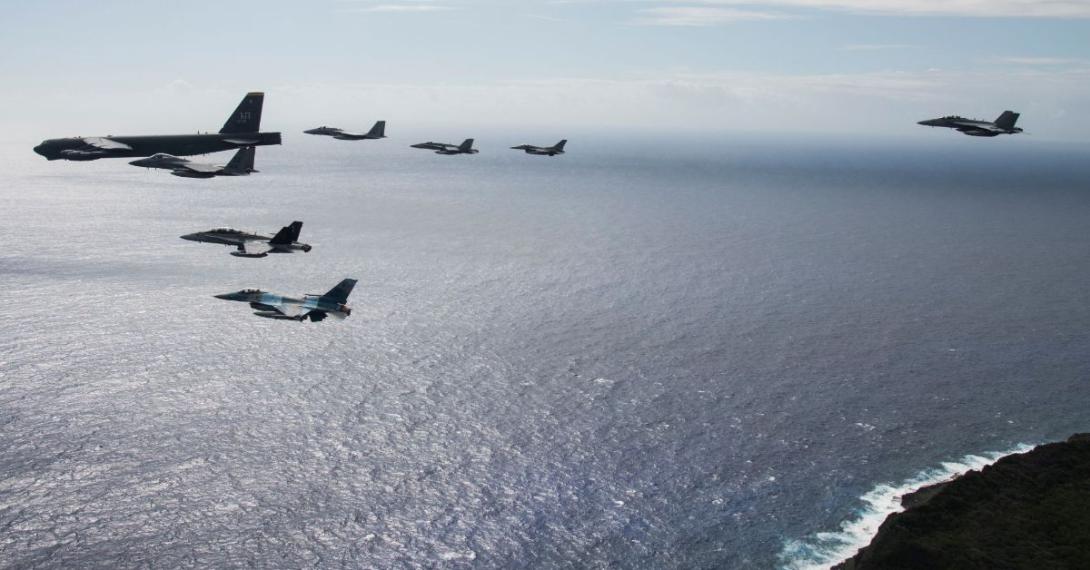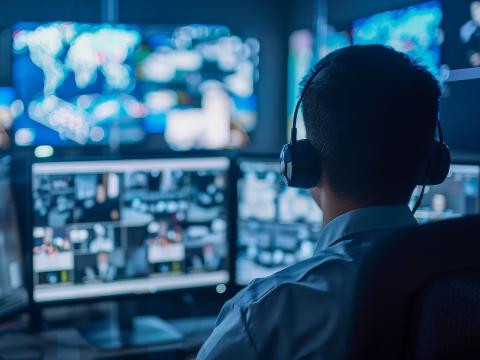The Growing Importance of Guam
Always strategic, the island of Guam in the western Pacific Ocean in Micronesia is playing a growing role in the contested, troublesome, near-peer competition environment. The Defense Department is investing more into the military facilities of this U.S. territory, including adding networking and bandwidth solutions; joint all-domain command and control; and intelligence, surveillance and reconnaissance solutions as well as additional U.S. forces. The measures will add key communications and advanced capabilities to the island as well as increase the military’s power projection abilities.
“One of the things that I talk about with respect to Guam is its strategic location on the globe,” says Gen. Kenneth Wilsbach, USAF, commander, Pacific Air Forces and the Air Component commander of U.S. Indo-Pacific Command. “Add the fact that it is U.S. sovereign territory. It’s the farthest western location that we have, that we can project from.” Gen. Wilsbach also is the executive director, Pacific Air Combat Operations Staff, Joint Base Pearl Harbor–Hickam, Hawaii.
In his role leading the Pacific Air Forces, or PACAF, Gen. Wilsbach is responsible for the Air Force’s efforts in the complex environment of the Indo-Pacific region, which spans over about half of the Earth’s surface, is home to 44 percent of the world’s trade and 60 percent of the world’s population. The general also supports more than 46,000 airmen serving principally in Japan, South Korea, Hawaii, Alaska and Guam.
The Defense Department’s Indo-Pacific Strategy from June of 2019 outlined the department’s position within the U.S. governmentwide strategy for the region. The Air Force’s role in that policy is to support the U.S. Indo-Pacific Command’s strategy and main objective of a free and open Indo-Pacific, the general explains.
With the Indo-Pacific as the priority theater for the U.S. military, the main goal is to build partnerships and promote a networked region, one that is able to unite in defense against the growing threats of China, Russia, North Korea and Iran. Given the geographical vastness of the Indo-Pacific region and the number of nation partners of various sizes, the United States’ relationships with allies and partners in the Pacific serve as a force multiplier. As the U.S. military works to build capabilities, conduct exercises, improve training and increase information sharing with these countries, Guam is an important strategic and centralized hub, says Gen. Wilsbach.
As a tactical axis, Guam serves key theater operations and logistical support to all U.S. forces in the region. Guam holds some of the Indo-Pacific’s most significant ammunition and fuel storage capabilities, key intelligence, surveillance and reconnaissance (ISR) solutions and protections for the island itself.
“The amount of firepower that we could generate from that island is tremendous,” Gen. Wilsbach notes. “The airfield itself is enormous, with two runways, lots of apron, lots of parking areas, a very large munitions storage area. And so, it’s a very capable airfield.”
On Guam, Andersen Air Force Base (Andersen AFB) hosts F-22 squadrons as well as the Bomber Task Force, depending on their evolving, agile missions. And as a U.S. joint military facility, the island also is host to Naval Base Guam, the Naval Computer and Telecommunications Station Finegayan, and the Guam Army National Guard.
“The joint aspect of Guam is really important to the Indo-Pacific Command,” the PACAF commander confirms. “We train not just with the U.S. Air Forces but also with joint forces. So frequently our Bomber Task Force missions as well as our fighter missions, the F-22’s that are there, we’ll train with the Navy and the Marines and the Army.”
Moreover, because Guam is a U.S. territory, it allows the military to project power from that far western point and do so without having to coordinate host nation approval.
“We greatly value our host nations in the region, such as Japan and Korea, and the other nations where we occasionally have our forces,” the general explains. “But any kind of power projection that we would want to do from those countries would always require host nation approval because it is their sovereign territory. With Guam, we don’t have to go through that wicket.”
The Defense Information Systems Agency, or DISA, has been heavily investing to boost many communications, ISR and networking aspects to Guam (see page 18).
The Air Force chose to conduct part of its key joint all-domain command and control, or JADC2, development and testing last fall around Guam—and Hawaii—and is in the process now of adding crucial JADC2 nodes to Guam.
Later this year, the Air Force will test the JADC2 system during two exercises: Northern Edge 21 and Talisman Saber 21—with DISA providing support with communications and information technology requirements through the agency’s Pacific Contingency/Exercise Branch.
“The region, including Guam, [will greatly benefit from the implementation] of JADC2, which is the ability to create joint effects that are synchronized in time and place with your joint partners to present dilemmas for your adversaries that come at a volume and pace that makes it really hard for them to deal with it,” the PACAF commander stipulates. “In order for you to do that, you have to have a communications system that allows you to know what they are doing and then to command and control your forces, to be able to take advantage of what you know about the adversary. And that system that allows you to do that as a communication system is really an Internet of Things called the Advanced Battle Management System (ABMS). And that’s what I need. We are in the process of acquiring the nodes of the ABMS as we speak.”
These multinodal communication links are meant to be mostly digital and work in a contested environment, he states.
“And so, if you and I wanted to communicate, we could do a telephone call or we could send a text or an email or we could have a VTC [video teleconferencing], or we could meet in person,” the general continues. “There are a number of different ways that we could communicate. And what we need from an ABMS is similar, so that if it is a contested environment, and if they take out the telephone, then we can still text. Or if they take out our video teleconferencing, we can still make a phone call, and so on and so forth. The nodes of that ABMS have to be robust, so that you can; one, continue to command and control your forces; and two, know what your adversary is up to, so that you make the right moves.”
Also, just before the pandemic, the Air Force hosted Cope North 2020 at Andersen AFB and across the Micronesia region in February 2020. The large-scale, trilateral exercise with Australia, Japan and the United States featured large force employment, and the coordination of weapons platforms and large numbers of aircraft—including B-52s, F-15s, F-16s, F-18s, among others—flying in the airspace at once. The two-week endeavor included approximately 1,200 sorties from the multinational, combined air power. Andersen AFB supported the operation of the multinational joint task force and the integration of the three nations along functional lines, which is not a common feat.
“Most bases don’t have enough assets to perform (large force employment) movements on their own,” says Col. Scott Rowe, USAF, who directed the exercise. “Cope North is one of those few chances to bring in an entire [trilateral] package to execute functions such as command and control, close air support, offensive and defensive counterair, and the different individual skill sets the participating units bring.”
In addition, the U.S. Marine Corps presence on the island has grown with the October 1, 2020, activation of Camp Blaz. Located in Dededo near Andersen AFB, Camp Blaz is the Marine Corps’ first new installation anywhere in the world since 1952. The establishment of a Marine Air-Ground Task Force on Guam is meant to boost the United States’ combat power in the Western Pacific. Initially, Camp Blaz will hold 5,000 Marines from the III Marine Expeditionary Force (MEF) relocating from Okinawa, Japan as part of a U.S.-Japan realignment plan. The agreement has the government of Japan providing $3.1 billion for facility construction in support of the Marines’ realignment to Guam, with the U.S. Defense Department providing $8.6 billion.
“There’s actually a tremendous amount of construction that’s going on at Andersen,” Gen. Wilsbach offers. “One side of the ramp is just full of hangars and ramp space that is being constructed, and a lot of that is for the U.S. Marines.”
For the first time, Guam hosted the trilateral Malabar Naval exercise in 2018, with U.S., Indian and Japanese aircraft carriers, destroyers and cruisers participating in the at-sea part of the exercise, along with an ashore contingent of the nations’ combined warfighters performing operations, maritime patrol, reconnaissance and anti-submarine warfare, among other activities.
“We conduct training with our allies and partners frequently,” shares Gen. Wilsbach. “We are training with Japan on the Bomber Task Force missions. In the past, we’ve trained with Australia, Korea, Singapore and Indonesia and others. [We are] really strengthening the bonds between those allies and partners, as well as improve the ability to be interoperable with them, which is really important to us.”
However, with this expanded posture, the need to protect Guam has also increased. A transfer of power ceremony in February 2019 positioned soldiers for the first time from the Guam Army National Guard to hold the mission for operating the Terminal High Altitude Area Defense, or THAAD, missile-defense system on the island. Having this first permanently forward-stationed THAAD battery that provides protections against tactical ballistic missiles is key to the defense of the U.S. territory.
“One of the things that has changed is that it used to be basically free from attack because of where it was,” the PACAF commander relates. “But in the 21st Century, Guam is now inside of the threat rings of some countries, like China, North Korea and Russia, who could threaten the island. So, we are defending it. We have a THAAD battery there. We have other [capabilities] to defend the island. That is the big change between the Vietnam Era and now. It is a big change from the standpoint of it is no longer outside the reach of any adversaries.”
Indeed, the PACAF commander supports installing on Guam the land-based advanced ballistic missile defense system, known as Aegis Ashore, called for by Adm. Phil Davidson, USN, Indo-Pacific commander.
“Aegis Ashore certainly has the capability to get after ballistic missiles and cruise missiles,” Gen. Wilsbach says. “It is a tremendous capability. It gives you that 360-degree coverage around the island to take care of threats that could be coming in from whichever azimuth.”
Additionally, the “unbelievably corrosive” sea salt environment on Guam necessitates infrastructure investments, the general relays. “Vehicles that normally have a 10- or 15-year life span, that is really hard to do there,” Gen. Wilsbach states. “Things just rust like you cannot even imagine. In fact, I saw a piece of aircraft generation equipment there recently that wasn’t even that old that was rusting very badly. It’s just a constant struggle to keep things from corroding, and the buildings are the same way. The buildings just take a beating with the salt air and the coral dust as well as the typhoons that run through there. So, renovating and modernizing the facilities will be a big part of that [infrastructure investment].”







Comments